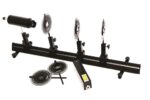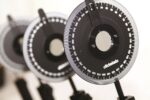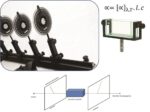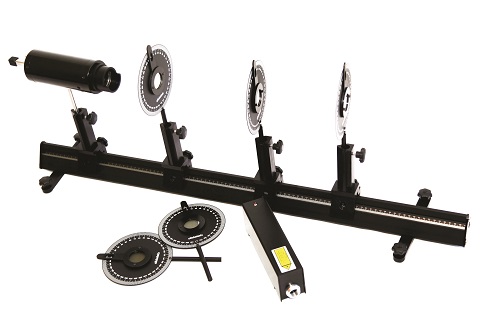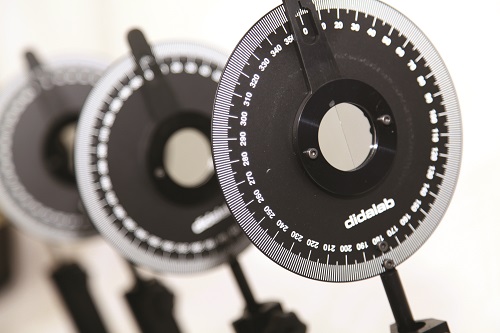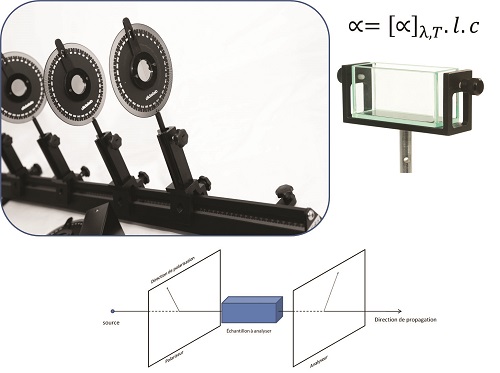Light is an electromagnetic wave, and its polarisation is characterised by the orientation of the electric (or magnetic) field in a plane perpendicular to its propagation. This comprehensive optical pack allows you to implement and study the basic principles of polarisation of light. You can study the state of polarisation of sources, verify Malus’s law, and analyse the effects of various polarisation retardation plates. Light intensities are displayed via an acquisition software connected to a USB photodiode. Using the parallel plate tank, the polarisation power of a sweet solution is studied, and Biot’s law is implemented.
LASER POLARISATION AND VERIFYING MALUS’S LAW
The laser is placed on the optical bench. Once laser polarisation direction has been determined, the polariser is placed according to the angle allowing maximum light intensity. A second polariser, acting as an analyser, is then placed. The photodiode detector is used to measure the light intensity received. The analyser is rotated, and the resulting light intensity read. By plotting the light intensity graph as a function of the analyser rotation angle, a sinusoidal shaped graph with extinctions is obtained. The remarkable angles are observed between the polariser and the analyser, yielding maximum light intensity values. Polarisation is linear.
IMPLEMENTING HALF-WAVE AND QUARTER-WAVE PLATES
The laser is placed on the bench, together with a quarter-wave plate, between the polariser and the analyser. The first polariser is placed at 90° and the quarter-wave plate at 45°, and the analyser is progressively rotated. We observe that analyser position does not affect polarisation. The quarter-wave plate is now placed at any angle, and the analyser is rotated. We observe that we do not attain total extinction, but minimum intensity.
VERIFYING BIOT’S LAW
Some “optically active” substances are able to change light polarisation direction. The substance is said to be
“dextrorotatory” when it changes polarisation direction to the right, and “levorotatory” when it changes polarisation
direction to the left. Biot’s law states that the angle of rotation is proportional to the concentration of active substance. This law can be verified by placing the parallel plate tank containing the active substance between the polariser and the analyser.
SUBJECTS APPROACHED
»»Malus’s law
»»Linear polarisation
»»Random polarisation
»»Biot’s law
»»Dextrorotatory and levorotatory substances
NECESSARY EQUIPMENT
COMPOSITION
EXP200041 Polarisation law (BASIC)
| Reference | Description | quantity |
| POF010112 | Prismatic optical bench, 1 m | 1 |
| POF010124 | Optical rider | 6 |
| POD013210 | HeNe Laser | 1 |
| POD012000 | BNC photodiode detector | 1 |
| POD060910 | Pair of polarizing filters | 1 |
| POD060955 | Quarter-wave plate, 430-700 nm | 1 |
| POD060965 | Half-wave plate, 430-700 nm | 1 | POD010002 | Millimetric metal screen | 1 |
COMPOSITION
EXP200040 Polarisation law (COMPLETE)
| Reference | Description | quantity |
| POF010112 | Prismatic optical bench, 1 m | 1 |
| POF010124 | Optical rider | 6 |
| DPO020100 | LED lantern, with frosted glass and “d” object | 1 |
| POD013210 | HeNe Laser | 1 |
| POD012000 | BNC photodiode detector | 1 |
| POD060910 | Pair of polarizing filters | 1 |
| POD060955 | Quarter-wave plate, 430-700 nm | 1 |
| POD060965 | Half-wave plate, 430-700 nm | 1 |
| POD060961 | Half-shadow polarimeter | 1 |
| POD010002 | Millimetric metal screen | 1 |
| POD060450 | Parallel plate tank | 1 |
- Non catégorisé
- Electrical Engineering
- PHYSICS
- Energy & Systems
- Catalogues
- PDF catalogues

